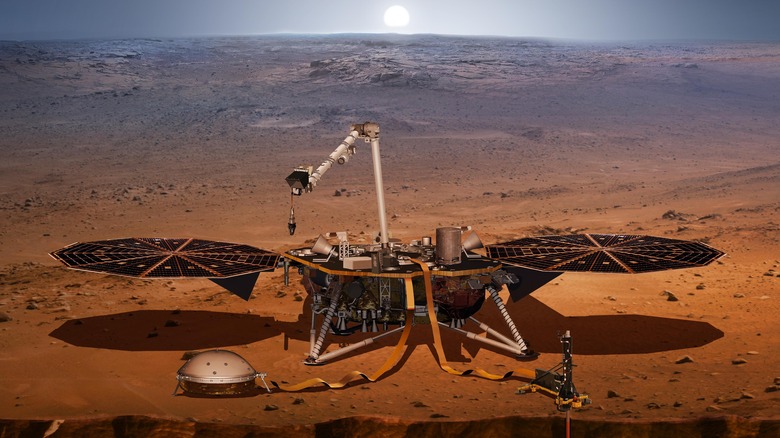NASA's InSight Lander Will Keep Hunting For Marsqakes As It Runs Out Of Power
NASA's InSight lander won't last for much longer until it runs out of power, but it will keep on working for as long as it can. The Mars lander, which studies the martian weather and the marsquakes that shake the planet, is expected to stop working by the end of the year 2022 (via JPL). The reason InSight will stop working is a common problem on Mars: dust. Mars experiences frequent dust storms, which pick up the small grains of dust that cover the planet and whip them up into the air, then dump them on everything — including landers.
The problem is that dust has accumulated on InSight's solar panels, each of which is 7 feet wide, blocking off the sunlight and preventing them from gathering as much power as they need. The InSight team has found ways to get around power limitations, but the problem will only get worse as time goes on. They have decided to focus the remaining power on the lander's seismometer instrument, so they will stop using the robotic arm and put it into a final resting position called, rather poignantly, its retirement pose.
With the saved power, they hope the seismometer could continue collecting data until December 2022, and there is a possibility they could get lucky and a strong wind could blow some of the dust away, giving them more time. "We've been hoping for a dust cleaning like we saw happen several times to the Spirit and Opportunity rovers," said the lead researcher of the InSight mission, Bruce Banerdt of NASA's Jet Propulsion Laboratory. "That's still possible, but energy is low enough that our focus is making the most of the science we can still collect."
What InSight has been studying
InSight's seismometer is being prioritized because that is the lander's primary instrument for studying marsquakes. Like Earth, Mars is periodically shaken by quakes, but unlike Earth, these aren't caused by tectonic plates. There are competing theories about whether these quakes are caused by fractures in the crust caused by the planet cooling or by volcanic activity beneath the surface (via phys.org). InSight has detected more than 1,300 marsquakes in its mission to date since it landed in 2018. Its primary mission was to study the marsquakes for two years, and this was extended so the lander could keep collecting data as long as possible.
By studying marsquakes, researchers can learn about the interior structure of Mars. They can see how the quakes pass through the interior of the planet, and from this they can deduce how solid or liquid the different layers are. Thanks to InSight, we know that Mars has a core 1,137 miles in radius, which is molten (unlike the core of Earth, which is solid) and surrounded by a mantle stretching 969 miles below the surface, as well as a crust that is surprisingly thin and may have two or three sublayers (via JPL).
This information isn't only teaching us about Mars, but it also gives us an idea of what other rocky exoplanets might be like. "InSight has transformed our understanding of the interiors of rocky planets and set the stage for future missions," said Lori Glaze, the director of the Planetary Science Division at NASA. "We can apply what we've learned about Mars' inner structure to Earth, the Moon, Venus, and even rocky planets in other solar systems."
